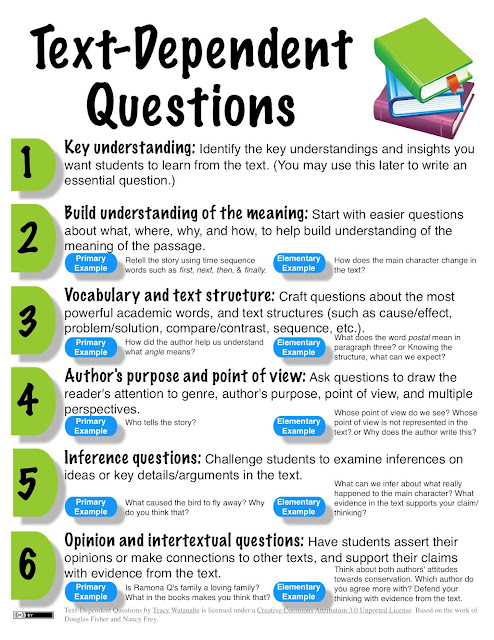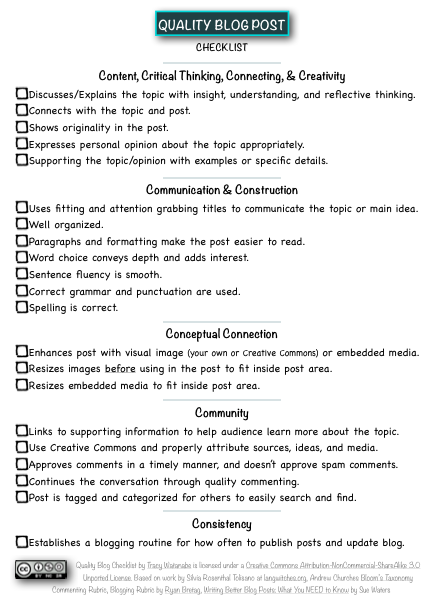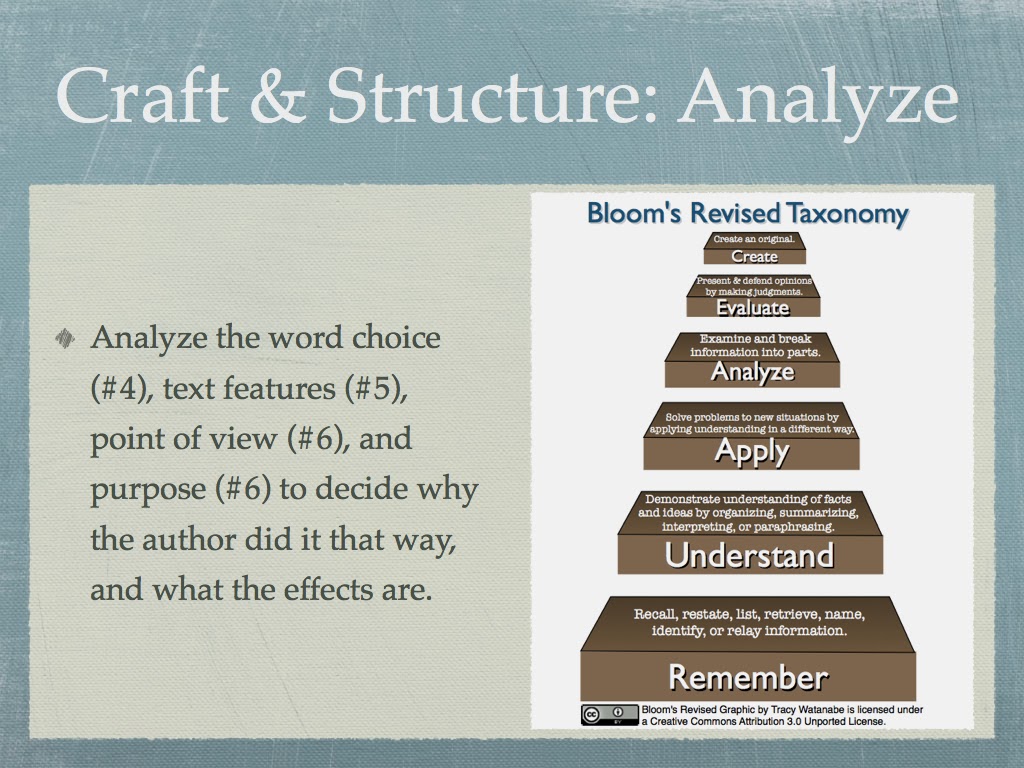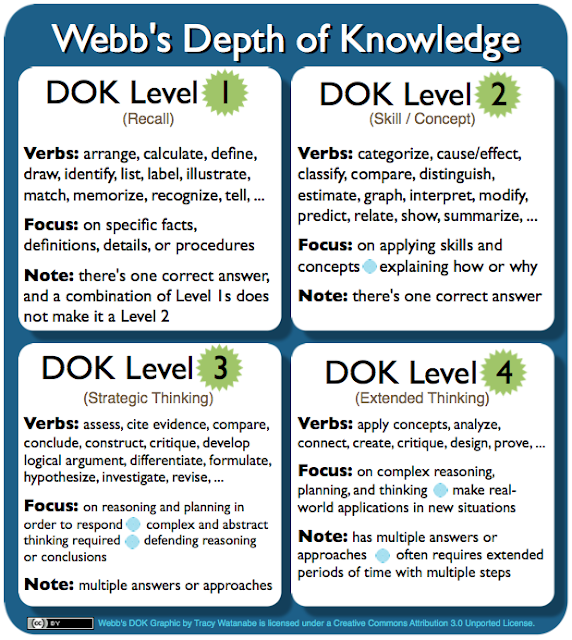Close Read Complex Text, and Annotate with Tech--Part 1
Text complexity with close reading
Complex text requires a close reading. So what makes a text complex? There are three "ingredients" to text complexity:
It's important to understand text complexity to build students' literacy skills. As they become more skilled, they will read more complex text on their own.
Introduction to close reading
Here's an overview of close reading:
What does close reading look like in the classroom?
Here are some examples of close reading at different grade levels and content areas (or components of it such as annotation):
- 9th-10th grade -- Thinking Notes: A Strategy to Encourage Close Reading by the Teaching Channel
- 10th grade, Close Reading with nonfiction
- 6th grade, Teaching Annotation
- 4th grade, Close Reading
- 3rd grade lesson, Close Reading on Aesop's Lion and Mouse
What are the steps for doing a close read?
 |
| Click here to download as PDF |
Close reading may look different at different ages and content areas. From the research I've done, all close reading has these components:
- Close reading is a strategy for reading complex text, something that would be at the student's frustration level. However, for primary grades, there are instances where the teacher reads aloud.
- It is good to do with short passages.
- There is limited pre-reading discussion and activities. Otherwise, the teacher might build up so much prior knowledge that the students don't need to do a close reading anymore.
- The text is read and reread several times.
- There are text-dependent questions.
- Students learn to annotate their thoughts as part of the process.
However, the amount of scaffolding and support needed will be based on the level of text complexity in relation to their independent/frustration reading level. Some scaffolds will (and should) be removed as time goes on, such as step six with the teacher reading and modeling annotation.
 |
| Poster CC By Tracy Watanabe & Photo CC By Denise Krebs |
Annotation
Annotation is an important part of close reading. Again, it will look different at the different grade levels.
- Click to download Read with a Pen -- Primary
- Click to download Read with a Pen -- Secondary
Annotating with iPads
For annotating with iPads, the students could take a photo of the text, then annotate using various apps.
- Educreations is a favorite because you can add pages and annotate on the pages with the tools. Educreations is an iPad app that can also be accessed from your browser. Once saved on the iPad, it will also save to the account created. Since Educreations is like an interactive whiteboard, it requires a narration to record and save.

- Noteability is another app that is easy to use. Unlike Educreations, it does not require a narration, but that is an option. It also can be saved to DropBox easily. (Note: It also works well with My Big Campus). Here's a brief tutorial on how to use it:
Annotating on a desktop computer
If the text is on the Internet, it would be easy to annotate in Diigo, or take a screen shot then annotate in Paint (or Pages, if you are working on a Mac) as well as Google Docs/Apps.
Text-dependent questions
There's not a set guide for creating text-dependent questions; however, I like to use Bloom's Revised Taxonomy with Webb's Depth of Knowledge or this poster as my guide:
Student Task
What can they do/create as evidence of learning? The culminating activity should capitalize on the key ideas, essential questions, or their understanding. It should include:
- mastery of one or more of the standards;
- writing;
- and, is structured as independent practice (for a formative assessment).
- Will it be graded? If so, a rubric needs to be created and shared with the students. If not, prepare a place to record anecdotal notes or a checklist of mastery.
- How will instruction change based on the information you've learned about student understanding? What scaffolds can you put in place to help, if needed. What extended learning can you provide (such as a blog post sharing their products with a community outside the classroom)?
- What specific feedback can you give the students to help them progress?
Final thoughts
Close reading won't take place all of the time, and it won't need all of the steps I've shared. It is a strategy that will look different for different texts based on the genre, purpose for the reading, the text complexity, and the student's ages.
While planning for close reading, consider your readers, your text, and how to support them with scaffolds. Scaffolds are meant to be taken away, therefore, the steps of a close read will change over time.
In Close Read Complex Text, and Annotate with Tech--Part 2, I will expand on annotating with iPads, and in Close Read Complex Text, and Annotate with Tech--Part 3, I expand with annotating with Diigo.
- If you have a great app or way to annotate with technology, please share. I'm interested in learning from you.
- What does close reading look like in your class?
- What tips or resources can you share about creating text-dependent questions?
- What other questions about close reading do you still have?
- How else does this post connect with you?





Tracy
ReplyDeleteThank you for sharing the poster on Text Dependent Questions. For me, this poster really helped me create text dependent questions. Instead of just looking back through the text to create my questions, I would think of very specific questions under each of the six catergories listed on the poster. This really helped me create questions that went from lower level to higher level.
Hi Jodi,
DeleteSo glad the poster is useful! It really helped me create text-dependent questions also. Thanks again for your encouragement to give this a try.
Kind regards,
Tracy
You should take a look at Subtext, an iPad app that can change the way you read with students. Thank you for sharing all of your great posters.
ReplyDeleteHi Heather,
DeleteThanks so much for sharing about Subtext! I have not seen that before and from the video I watched, I'm excited to give it a try. I saw that it was currently free and works with Edmodo also. Thanks!
Kind regards,
Tracy
Here is a presentation I created on Haiku Deck for using Subtext & Edmodo:
Deletehttp://www.haikudeck.com/p/LoRuSl1JSJ/subtext--edmodo
What a WOW post about close reading! Thanks for all of this information. I pinned it so I can read "closer" later. :)
ReplyDeleteShannon
http://www.irunreadteach.wordpress.com
Thanks Shannon!
DeleteWhat great information, Tracy! I share CCSS information with teachers in my district at http://www.scoop.it/t/common-core-state-standards-smusd. Yours is the most comprehensive and helpful article I've seen! Thanks for sharing.
ReplyDeleteThanks Mary! You've created a great Scoop It about CCSS. I appreciate your sharing.
DeleteKind regards,
Tracy
I keep coming back to this article as I prepare close reading trainings with teachers, as well as others you have. Thank you so much for sharing your thoughts.
ReplyDeleteI used this article in my graduate course today! You are amazing!!! Theresa
ReplyDelete